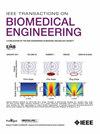Assessment of Aortic Dissection Remodeling With Patient-Specific Fluid–Structure Interaction Models
IF 4.4
2区 医学
Q2 ENGINEERING, BIOMEDICAL
引用次数: 0
Abstract
Aortic dissection leads to late complications due tochronic degeneration and dilatation of the false lumen. This study examines the interaction between hemodynamics and long-term remodeling of a patient's aortic dissection, tracked from pre-dissection to the chronic phase using CT angiography. Fluid–structure interaction models with tissue prestress, external support, and anisotropic properties were used to analyze hemodynamic markers. Each aortic wall layer had distinct thicknesses and material properties. The boundary conditions were guided by利用患者特异性流体-结构相互作用模型评估主动脉夹层重塑。
主动脉夹层会导致假腔慢性变性和扩张,从而引发晚期并发症。然而,血液动力学和微结构重塑之间的相互作用如何推动长期变化尚未完全明了。本研究使用计算机断层扫描血管造影术对主动脉夹层患者从夹层前到慢性阶段的进展情况进行了研究。流体-结构相互作用模型考虑了组织预应力、外部支撑和各向异性,用于分析血液动力学标记。每个主动脉壁层都有不同的厚度和材料特性。边界条件以体外 4D 流磁共振成像和患者血压为指导。常规临床护理期间的定量测量显示,主动脉扩张在左锁骨下动脉远端最为显著,在慢性期达到 6 厘米。模拟结果显示,流经入口撕裂处的射流速度在亚急性期达到 185 厘米/秒的峰值,而在慢性期则降至 123 至 133 厘米/秒,这与入口撕裂的增大相对应。在亚急性期和慢性期,血流射流撞击假腔导致局部压力分别增加 11 和 2 毫米汞柱,管壁剪应力达到 4,Pa 。这些血流动力学变化似乎是主动脉生长和形态变化的主要驱动力。尽管皮瓣整体移动幅度不大,但随着病情的发展,平面内位移从 0.6 毫米增加到 1.8 毫米,这与主动脉直径的整体增加有关。在亚急性阶段,皮瓣硬度显著降低的额外模拟导致皮瓣运动增加到 9.5 毫米。尽管这些结果是基于单个患者,但它们表明血液动力学与主动脉生长之间存在密切关系。
本文章由计算机程序翻译,如有差异,请以英文原文为准。
求助全文
约1分钟内获得全文
求助全文
来源期刊

IEEE Transactions on Biomedical Engineering
工程技术-工程:生物医学
CiteScore
9.40
自引率
4.30%
发文量
880
审稿时长
2.5 months
期刊介绍:
IEEE Transactions on Biomedical Engineering contains basic and applied papers dealing with biomedical engineering. Papers range from engineering development in methods and techniques with biomedical applications to experimental and clinical investigations with engineering contributions.
 求助内容:
求助内容: 应助结果提醒方式:
应助结果提醒方式:


